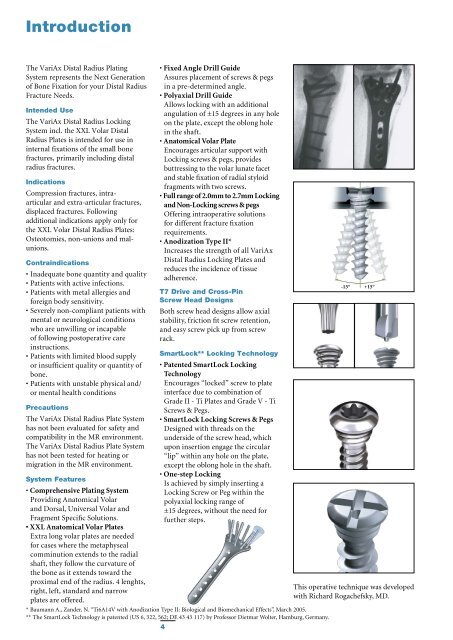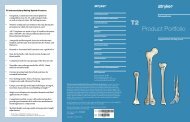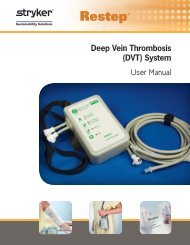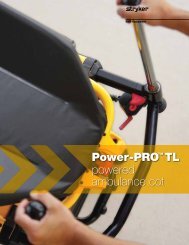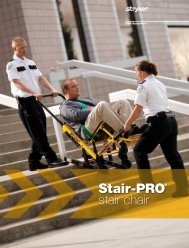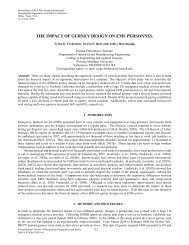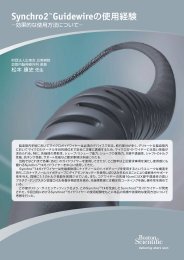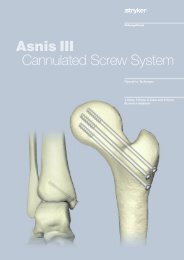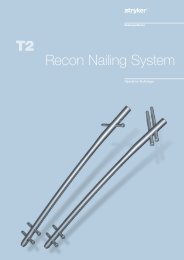VariAxDistal Radius Locking Plate System - Stryker
VariAxDistal Radius Locking Plate System - Stryker
VariAxDistal Radius Locking Plate System - Stryker
You also want an ePaper? Increase the reach of your titles
YUMPU automatically turns print PDFs into web optimized ePapers that Google loves.
IntroductionThe VariAx Distal <strong>Radius</strong> Plating<strong>System</strong> represents the Next Generationof Bone Fixation for your Distal <strong>Radius</strong>Fracture Needs.Intended UseThe VariAx Distal <strong>Radius</strong> <strong>Locking</strong><strong>System</strong> incl. the XXL Volar Distal<strong>Radius</strong> <strong>Plate</strong>s is intended for use ininternal fixations of the small bonefractures, primarily including distalradius fractures.IndicationsCompression fractures, intraarticularand extra-articular fractures,displaced fractures. Followingadditional indications apply only forthe XXL Volar Distal <strong>Radius</strong> <strong>Plate</strong>s:Osteotomies, non-unions and malunions.Contraindications• Inadequate bone quantity and quality• Patients with active infections.• Patients with metal allergies andforeign body sensitivity.• Severely non-compliant patients withmental or neurological conditionswho are unwilling or incapableof following postoperative careinstructions.• Patients with limited blood supplyor insufficient quality or quantity ofbone.• Patients with unstable physical and/or mental health conditionsPrecautionsThe VariAx Distal <strong>Radius</strong> <strong>Plate</strong> <strong>System</strong>has not been evaluated for safety andcompatibility in the MR environment.The VariAx Distal <strong>Radius</strong> <strong>Plate</strong> <strong>System</strong>has not been tested for heating ormigration in the MR environment.<strong>System</strong> Features• Comprehensive Plating <strong>System</strong>Providing Anatomical Volarand Dorsal, Universal Volar andFragment Specific Solutions.• XXL Anatomical Volar <strong>Plate</strong>sExtra long volar plates are neededfor cases where the metaphysealcomminution extends to the radialshaft, they follow the curvature ofthe bone as it extends toward theproximal end of the radius. 4 lenghts,right, left, standard and narrowplates are offered.• Fixed Angle Drill GuideAssures placement of screws & pegsin a pre-determined angle.• Polyaxial Drill GuideAllows locking with an additionalangulation of ±15 degrees in any holeon the plate, except the oblong holein the shaft.• Anatomical Volar <strong>Plate</strong>Encourages articular support with<strong>Locking</strong> screws & pegs, providesbuttressing to the volar lunate facetand stable fixation of radial styloidfragments with two screws.• Full range of 2.0mm to 2.7mm <strong>Locking</strong>and Non-<strong>Locking</strong> screws & pegsOffering intraoperative solutionsfor different fracture fixationrequirements.• Anodization Type II*Increases the strength of all <strong>VariAxDistal</strong> <strong>Radius</strong> <strong>Locking</strong> <strong>Plate</strong>s andreduces the incidence of tissueadherence.T7 Drive and Cross-PinScrew Head DesignsBoth screw head designs allow axialstability, friction fit screw retention,and easy screw pick up from screwrack.SmartLock** <strong>Locking</strong> Technology• Patented SmartLock <strong>Locking</strong>TechnologyEncourages “locked” screw to plateinterface due to combination ofGrade II - Ti <strong>Plate</strong>s and Grade V - TiScrews & Pegs.• SmartLock <strong>Locking</strong> Screws & PegsDesigned with threads on theunderside of the screw head, whichupon insertion engage the circular“lip” within any hole on the plate,except the oblong hole in the shaft.• One-step <strong>Locking</strong>Is achieved by simply inserting a<strong>Locking</strong> Screw or Peg within thepolyaxial locking range of±15 degrees, without the need forfurther steps.* Baumann A., Zander, N. “Ti6A14V with Anodization Type II: Biological and Biomechanical Effects”, March 2005.** The SmartLock Technology is patented (US 6, 322, 562; DE 43 43 117) by Professor Dietmar Wolter, Hamburg, Germany.4-15° +15°This operative technique was developedwith Richard Rogachefsky, MD.


